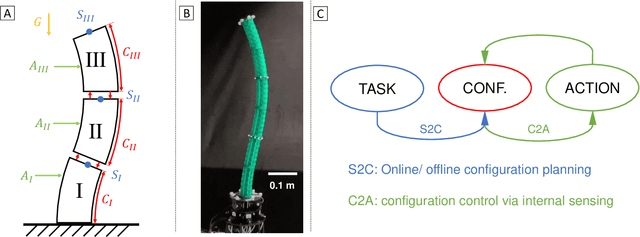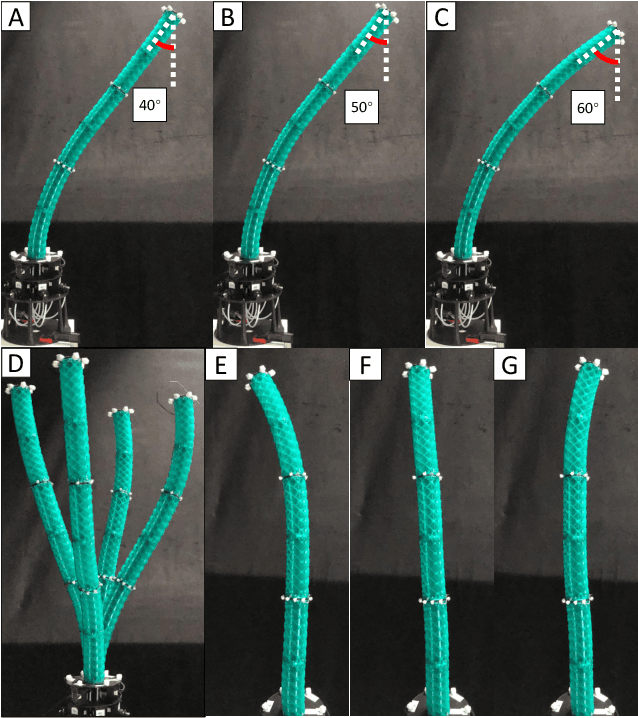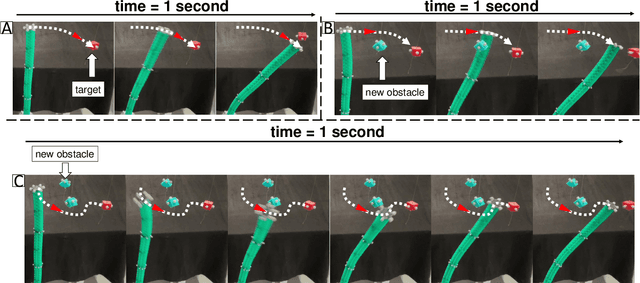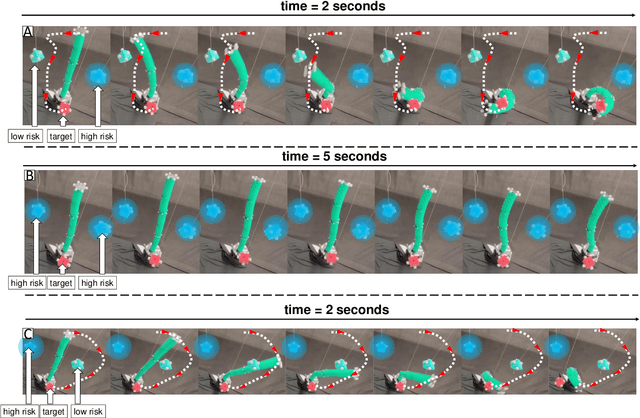Zixi Chen
A Survey on Soft Robot Adaptability: Implementations, Applications, and Prospects
Jun 24, 2025Abstract:Soft robots, compared to rigid robots, possess inherent advantages, including higher degrees of freedom, compliance, and enhanced safety, which have contributed to their increasing application across various fields. Among these benefits, adaptability is particularly noteworthy. In this paper, adaptability in soft robots is categorized into external and internal adaptability. External adaptability refers to the robot's ability to adjust, either passively or actively, to variations in environments, object properties, geometries, and task dynamics. Internal adaptability refers to the robot's ability to cope with internal variations, such as manufacturing tolerances or material aging, and to generalize control strategies across different robots. As the field of soft robotics continues to evolve, the significance of adaptability has become increasingly pronounced. In this review, we summarize various approaches to enhancing the adaptability of soft robots, including design, sensing, and control strategies. Additionally, we assess the impact of adaptability on applications such as surgery, wearable devices, locomotion, and manipulation. We also discuss the limitations of soft robotics adaptability and prospective directions for future research. By analyzing adaptability through the lenses of implementation, application, and challenges, this paper aims to provide a comprehensive understanding of this essential characteristic in soft robotics and its implications for diverse applications.
Ultrasound-Guided Robotic Blood Drawing and In Vivo Studies on Submillimetre Vessels of Rats
Apr 04, 2025Abstract:Billions of vascular access procedures are performed annually worldwide, serving as a crucial first step in various clinical diagnostic and therapeutic procedures. For pediatric or elderly individuals, whose vessels are small in size (typically 2 to 3 mm in diameter for adults and less than 1 mm in children), vascular access can be highly challenging. This study presents an image-guided robotic system aimed at enhancing the accuracy of difficult vascular access procedures. The system integrates a 6-DoF robotic arm with a 3-DoF end-effector, ensuring precise navigation and needle insertion. Multi-modal imaging and sensing technologies have been utilized to endow the medical robot with precision and safety, while ultrasound imaging guidance is specifically evaluated in this study. To evaluate in vivo vascular access in submillimeter vessels, we conducted ultrasound-guided robotic blood drawing on the tail veins (with a diameter of 0.7 plus or minus 0.2 mm) of 40 rats. The results demonstrate that the system achieved a first-attempt success rate of 95 percent. The high first-attempt success rate in intravenous vascular access, even with small blood vessels, demonstrates the system's effectiveness in performing these procedures. This capability reduces the risk of failed attempts, minimizes patient discomfort, and enhances clinical efficiency.
Tacchi 2.0: A Low Computational Cost and Comprehensive Dynamic Contact Simulator for Vision-based Tactile Sensors
Mar 12, 2025Abstract:With the development of robotics technology, some tactile sensors, such as vision-based sensors, have been applied to contact-rich robotics tasks. However, the durability of vision-based tactile sensors significantly increases the cost of tactile information acquisition. Utilizing simulation to generate tactile data has emerged as a reliable approach to address this issue. While data-driven methods for tactile data generation lack robustness, finite element methods (FEM) based approaches require significant computational costs. To address these issues, we integrated a pinhole camera model into the low computational cost vision-based tactile simulator Tacchi that used the Material Point Method (MPM) as the simulated method, completing the simulation of marker motion images. We upgraded Tacchi and introduced Tacchi 2.0. This simulator can simulate tactile images, marked motion images, and joint images under different motion states like pressing, slipping, and rotating. Experimental results demonstrate the reliability of our method and its robustness across various vision-based tactile sensors.
Predicting Quality of Video Gaming Experience Using Global-Scale Telemetry Data and Federated Learning
Dec 12, 2024Abstract:Frames Per Second (FPS) significantly affects the gaming experience. Providing players with accurate FPS estimates prior to purchase benefits both players and game developers. However, we have a limited understanding of how to predict a game's FPS performance on a specific device. In this paper, we first conduct a comprehensive analysis of a wide range of factors that may affect game FPS on a global-scale dataset to identify the determinants of FPS. This includes player-side and game-side characteristics, as well as country-level socio-economic statistics. Furthermore, recognizing that accurate FPS predictions require extensive user data, which raises privacy concerns, we propose a federated learning-based model to ensure user privacy. Each player and game is assigned a unique learnable knowledge kernel that gradually extracts latent features for improved accuracy. We also introduce a novel training and prediction scheme that allows these kernels to be dynamically plug-and-play, effectively addressing cold start issues. To train this model with minimal bias, we collected a large telemetry dataset from 224 countries and regions, 100,000 users, and 835 games. Our model achieved a mean Wasserstein distance of 0.469 between predicted and ground truth FPS distributions, outperforming all baseline methods.
S2C2A: A Flexible Task Space Planning and Control Strategy for Modular Soft Robot Arms
Oct 04, 2024



Abstract:Modular soft robot arms (MSRAs) are composed of multiple independent modules connected in a sequence. Due to their modular structure and high degrees of freedom (DOFs), these modules can simultaneously bend at different angles in various directions, enabling complex deformation. This capability allows MSRAs to perform more intricate tasks than single module robots. However, the modular structure also induces challenges in accurate planning, modeling, and control. Nonlinearity, hysteresis, and gravity complicate the physical model, while the modular structure and increased DOFs further lead to accumulative errors along the sequence. To address these challenges, we propose a flexible task space planning and control strategy for MSRAs, named S2C2A (State to Configuration to Action). Our approach formulates an optimization problem, S2C (State to Configuration planning), which integrates various loss functions and a forward MSRA model to generate configuration trajectories based on target MSRA states. Given the model complexity, we leverage a biLSTM network as the forward model. Subsequently, a configuration controller C2A (Configuration to Action control) is implemented to follow the planned configuration trajectories, leveraging only inaccurate internal sensing feedback. Both a biLSTM network and a physical model are utilized for configuration control. We validated our strategy using a cable-driven MSRA, demonstrating its ability to perform diverse offline tasks such as position control, orientation control, and obstacle avoidance. Furthermore, our strategy endows MSRA with online interaction capability with targets and obstacles. Future work will focus on addressing MSRA challenges, such as developing more accurate physical models and reducing configuration estimation errors along the module sequence.
Searching for Efficient Linear Layers over a Continuous Space of Structured Matrices
Oct 03, 2024



Abstract:Dense linear layers are the dominant computational bottleneck in large neural networks, presenting a critical need for more efficient alternatives. Previous efforts focused on a small number of hand-crafted structured matrices and neglected to investigate whether these structures can surpass dense layers in terms of compute-optimal scaling laws when both the model size and training examples are optimally allocated. In this work, we present a unifying framework that enables searching among all linear operators expressible via an Einstein summation. This framework encompasses many previously proposed structures, such as low-rank, Kronecker, Tensor-Train, Block Tensor-Train (BTT), and Monarch, along with many novel structures. To analyze the framework, we develop a taxonomy of all such operators based on their computational and algebraic properties and show that differences in the compute-optimal scaling laws are mostly governed by a small number of variables that we introduce. Namely, a small $\omega$ (which measures parameter sharing) and large $\psi$ (which measures the rank) reliably led to better scaling laws. Guided by the insight that full-rank structures that maximize parameters per unit of compute perform the best, we propose BTT-MoE, a novel Mixture-of-Experts (MoE) architecture obtained by sparsifying computation in the BTT structure. In contrast to the standard sparse MoE for each entire feed-forward network, BTT-MoE learns an MoE in every single linear layer of the model, including the projection matrices in the attention blocks. We find BTT-MoE provides a substantial compute-efficiency gain over dense layers and standard MoE.
On the Resilience of Multi-Agent Systems with Malicious Agents
Aug 02, 2024Abstract:Multi-agent systems, powered by large language models, have shown great abilities across various tasks due to the collaboration of expert agents, each focusing on a specific domain. However, when agents are deployed separately, there is a risk that malicious users may introduce malicious agents who generate incorrect or irrelevant results that are too stealthy to be identified by other non-specialized agents. Therefore, this paper investigates two essential questions: (1) What is the resilience of various multi-agent system structures (e.g., A$\rightarrow$B$\rightarrow$C, A$\leftrightarrow$B$\leftrightarrow$C) under malicious agents, on different downstream tasks? (2) How can we increase system resilience to defend against malicious agents? To simulate malicious agents, we devise two methods, AutoTransform and AutoInject, to transform any agent into a malicious one while preserving its functional integrity. We run comprehensive experiments on four downstream multi-agent systems tasks, namely code generation, math problems, translation, and text evaluation. Results suggest that the "hierarchical" multi-agent structure, i.e., A$\rightarrow$(B$\leftrightarrow$C), exhibits superior resilience with the lowest performance drop of $23.6\%$, compared to $46.4\%$ and $49.8\%$ of other two structures. Additionally, we show the promise of improving multi-agent system resilience by demonstrating that two defense methods, introducing an additional agent to review and correct messages or mechanisms for each agent to challenge others' outputs, can enhance system resilience. Our code and data are available at https://github.com/CUHK-ARISE/MAS-Resilience.
Data-driven Explainable Controller for Soft Robots based on Recurrent Neural Networks
Jun 06, 2024Abstract:The nonlinearity and hysteresis of soft robot motions have posed challenges in accurate soft robot control. Neural networks, especially recurrent neural networks (RNNs), have been widely leveraged for this issue due to their nonlinear activation functions and recurrent structures. Although they have shown satisfying accuracy in most tasks, these black-box approaches are not explainable, and hence, they are unsuitable for areas with high safety requirements, like robot-assisted surgery. Based on the RNN controllers, we propose a data-driven explainable controller (DDEC) whose parameters can be updated online. We discuss the Jacobian controller and kinematics controller in theory and demonstrate that they are only special cases of DDEC. Moreover, we utilize RNN, the Jacobian controller, the kinematics controller, and DDECs for trajectory following tasks. Experimental results have shown that our approach outperforms the other controllers considering trajectory following errors while being explainable. We also conduct a study to explore and explain the functions of each DDEC component. This is the first interpretable soft robot controller that overcomes the shortcomings of both NN controllers and interpretable controllers. Future work may involve proposing different DDECs based on different RNN controllers and exploiting them for high-safety-required applications.
Soft Contact Simulation and Manipulation Learning of Deformable Objects with Vision-based Tactile Sensor
May 12, 2024



Abstract:Deformable object manipulation is a classical and challenging research area in robotics. Compared with rigid object manipulation, this problem is more complex due to the deformation properties including elastic, plastic, and elastoplastic deformation. In this paper, we describe a new deformable object manipulation method including soft contact simulation, manipulation learning, and sim-to-real transfer. We propose a novel approach utilizing Vision-Based Tactile Sensors (VBTSs) as the end-effector in simulation to produce observations like relative position, squeezed area, and object contour, which are transferable to real robots. For a more realistic contact simulation, a new simulation environment including elastic, plastic, and elastoplastic deformations is created. We utilize RL strategies to train agents in the simulation, and expert demonstrations are applied for challenging tasks. Finally, we build a real experimental platform to complete the sim-to-real transfer and achieve a 90% success rate on difficult tasks such as cylinder and sphere. To test the robustness of our method, we use plasticine of different hardness and sizes to repeat the tasks including cylinder and sphere. The experimental results show superior performances of deformable object manipulation with the proposed method.
Simulation of Optical Tactile Sensors Supporting Slip and Rotation using Path Tracing and IMPM
May 05, 2024



Abstract:Optical tactile sensors are extensively utilized in intelligent robot manipulation due to their ability to acquire high-resolution tactile information at a lower cost. However, achieving adequate reality and versatility in simulating optical tactile sensors is challenging. In this paper, we propose a simulation method and validate its effectiveness through experiments. We utilize path tracing for image rendering, achieving higher similarity to real data than the baseline method in simulating pressing scenarios. Additionally, we apply the improved Material Point Method(IMPM) algorithm to simulate the relative rest between the object and the elastomer surface when the object is in motion, enabling more accurate simulation of complex manipulations such as slip and rotation.
 Add to Chrome
Add to Chrome Add to Firefox
Add to Firefox Add to Edge
Add to Edge